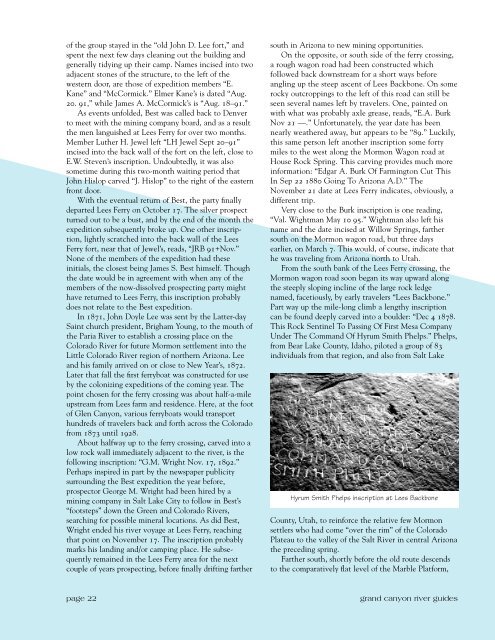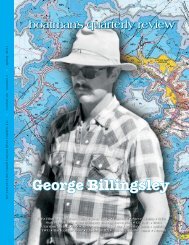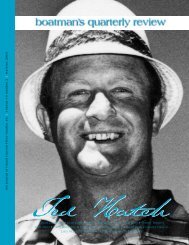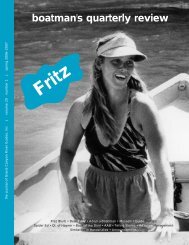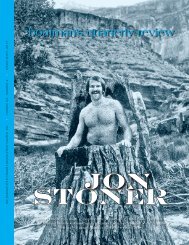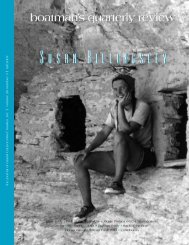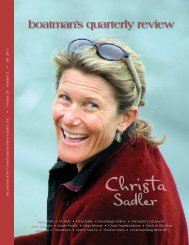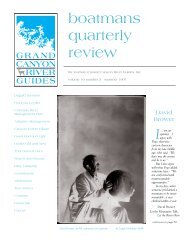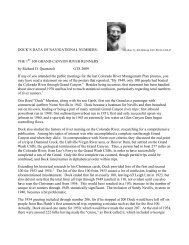spring 04 / 17:1 - Grand Canyon River Guides
spring 04 / 17:1 - Grand Canyon River Guides
spring 04 / 17:1 - Grand Canyon River Guides
You also want an ePaper? Increase the reach of your titles
YUMPU automatically turns print PDFs into web optimized ePapers that Google loves.
of the group stayed in the “old John D. Lee fort,” and<br />
spent the next few days cleaning out the building and<br />
generally tidying up their camp. Names incised into two<br />
adjacent stones of the structure, to the left of the<br />
western door, are those of expedition members “E.<br />
Kane” and “McCormick.” Elmer Kane’s is dated “Aug.<br />
20. 91,” while James A. McCormick’s is “Aug. 18–91.”<br />
As events unfolded, Best was called back to Denver<br />
to meet with the mining company board, and as a result<br />
the men languished at Lees Ferry for over two months.<br />
Member Luther H. Jewel left “LH Jewel Sept 20–91”<br />
incised into the back wall of the fort on the left, close to<br />
E.W. Steven’s inscription. Undoubtedly, it was also<br />
sometime during this two-month waiting period that<br />
John Hislop carved “J. Hislop” to the right of the eastern<br />
front door.<br />
With the eventual return of Best, the party finally<br />
departed Lees Ferry on October <strong>17</strong>. The silver prospect<br />
turned out to be a bust, and by the end of the month the<br />
expedition subsequently broke up. One other inscription,<br />
lightly scratched into the back wall of the Lees<br />
Ferry fort, near that of Jewel’s, reads, “JRB 91+Nov.”<br />
None of the members of the expedition had these<br />
initials, the closest being James S. Best himself. Though<br />
the date would be in agreement with when any of the<br />
members of the now-dissolved prospecting party might<br />
have returned to Lees Ferry, this inscription probably<br />
does not relate to the Best expedition.<br />
In 1871, John Doyle Lee was sent by the Latter-day<br />
Saint church president, Brigham Young, to the mouth of<br />
the Paria <strong>River</strong> to establish a crossing place on the<br />
Colorado <strong>River</strong> for future Mormon settlement into the<br />
Little Colorado <strong>River</strong> region of northern Arizona. Lee<br />
and his family arrived on or close to New Year’s, 1872.<br />
Later that fall the first ferryboat was constructed for use<br />
by the colonizing expeditions of the coming year. The<br />
point chosen for the ferry crossing was about half-a-mile<br />
upstream from Lees farm and residence. Here, at the foot<br />
of Glen <strong>Canyon</strong>, various ferryboats would transport<br />
hundreds of travelers back and forth across the Colorado<br />
from 1873 until 1928.<br />
About halfway up to the ferry crossing, carved into a<br />
low rock wall immediately adjacent to the river, is the<br />
following inscription: “G.M. Wright Nov. <strong>17</strong>, 1892.”<br />
Perhaps inspired in part by the newspaper publicity<br />
surrounding the Best expedition the year before,<br />
prospector George M. Wright had been hired by a<br />
mining company in Salt Lake City to follow in Best’s<br />
“footsteps” down the Green and Colorado <strong>River</strong>s,<br />
searching for possible mineral locations. As did Best,<br />
Wright ended his river voyage at Lees Ferry, reaching<br />
that point on November <strong>17</strong>. The inscription probably<br />
marks his landing and/or camping place. He subsequently<br />
remained in the Lees Ferry area for the next<br />
couple of years prospecting, before finally drifting farther<br />
south in Arizona to new mining opportunities.<br />
On the opposite, or south side of the ferry crossing,<br />
a rough wagon road had been constructed which<br />
followed back downstream for a short ways before<br />
angling up the steep ascent of Lees Backbone. On some<br />
rocky outcroppings to the left of this road can still be<br />
seen several names left by travelers. One, painted on<br />
with what was probably axle grease, reads, “E.A. Burk<br />
Nov 21 —.” Unfortunately, the year date has been<br />
nearly weathered away, but appears to be “89.” Luckily,<br />
this same person left another inscription some forty<br />
miles to the west along the Mormon Wagon road at<br />
House Rock Spring. This carving provides much more<br />
information: “Edgar A. Burk Of Farmington Cut This<br />
In Sep 22 1880 Going To Arizona A.D.” The<br />
November 21 date at Lees Ferry indicates, obviously, a<br />
different trip.<br />
Very close to the Burk inscription is one reading,<br />
“Val. Wightman May 10 95.” Wightman also left his<br />
name and the date incised at Willow Springs, farther<br />
south on the Mormon wagon road, but three days<br />
earlier, on March 7. This would, of course, indicate that<br />
he was traveling from Arizona north to Utah.<br />
From the south bank of the Lees Ferry crossing, the<br />
Mormon wagon road soon began its way upward along<br />
the steeply sloping incline of the large rock ledge<br />
named, facetiously, by early travelers “Lees Backbone.”<br />
Part way up the mile-long climb a lengthy inscription<br />
can be found deeply carved into a boulder: “Dec 4 1878.<br />
This Rock Sentinel To Passing Of First Mesa Company<br />
Under The Command Of Hyrum Smith Phelps.” Phelps,<br />
from Bear Lake County, Idaho, piloted a group of 83<br />
individuals from that region, and also from Salt Lake<br />
Hyrum Smith Phelps inscription at Lees Backbone<br />
County, Utah, to reinforce the relative few Mormon<br />
settlers who had come “over the rim” of the Colorado<br />
Plateau to the valley of the Salt <strong>River</strong> in central Arizona<br />
the preceding <strong>spring</strong>.<br />
Farther south, shortly before the old route descends<br />
to the comparatively flat level of the Marble Platform,<br />
page 22<br />
grand canyon river guides


